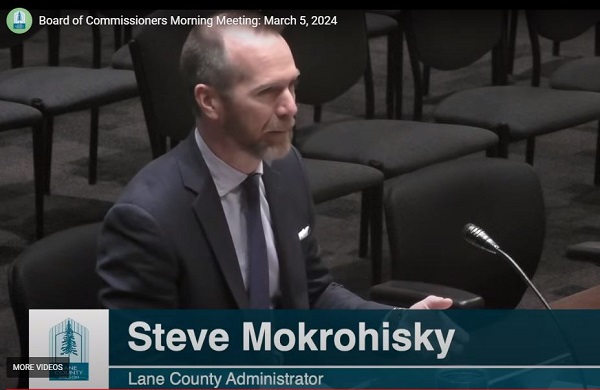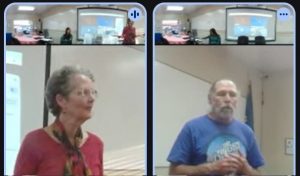Lane County prepares to discuss ice storm response
5 min read
The president is expected to declare the January ice storm a major disaster. On March 5:
Steve Mokrohisky: I wanted to give you an update on our emergency response work, particularly in the aftermath of the ice storm. So over the past several weeks, we’ve had joint meetings with the Federal Emergency Management Agency (FEMA), and the Oregon Department of Emergency Management staff that have been in town meeting with our various public utility partners, our cities, our special districts, to complete the preliminary damage assessment process. This preliminary damage assessment process is needed to support the governor’s request for a presidential disaster declaration.
[00:00:43] All the indicators continue to support that we are very likely to be declared in the major disaster category by the president, the timing of which we were told is likely to happen in early to mid-April. So that is, of course, is not a guarantee, but we feel like by all the metrics, we think we should be.
[00:01:00] We’ve been continuing forward in our formal after-action learning process. We call this oftentimes a ‘hot wash.’ That’s sort of our slang. But it is the formal after-action learning process is what we’ve been going through, gathering the lessons learned from our response.
[00:01:16] Our new emergency manager, Tiffany Brown, has done a terrific job leading the way in the process. She led the conversation with county leadership and response staff on Feb. 5. It was literally her first day on the job. She facilitated that internal debriefing process. And then as the team has digested those discussions on Feb. 5, we’ve heard from partners around the county.
[00:01:43] It’s clear that we need to organize a series of smaller, more focused hot washes to drill into various issues from transportation, communication, sheltering, mass care, and other issues in greater detail. The result of these hot washes—these various sort of micro-hot washes—with those different—it’s more effective, really, than having a room of 100 people that are coming from all over, right, to break it out into the different disciplines and focus on those categories.
[00:02:08] Those results are already being added to our emergency operations plan and we plan to come back to the board with Tiffany to brief you on what we’ve learned from the process and some of the changes that we’re implementing. I think hopefully that will happen in April or May. I’m not exactly sure the timeframe of that. But I just want to keep that at the front of your front or back of your mind for now so that you know.
[00:02:31] That’s something we’ve talked about. You’ve had public comment on that issue. And we’ve been doing a lot of work (again, Commissioner Farr, to your point, I made this comment recently), we will bring that to light for the board and the public here in the coming weeks. Happy to answer any questions on that.
[00:02:41] The other thing I want to update you all on our grant requests. We’ve shared some specific successes we’ve had, particularly with our policy team. And I want to highlight a number of grant proposals that we have put in and the extent to which, you know, we’ve done some of—a lot of—these things in the past, but they’ve been isolated within various departments or agencies. What’s happening now is we’re using our policy team to help connect the dots and leverage different partnerships and assets that we have both internal to the organization and external partners.
[00:03:17] So I want to give you a few examples of that. And we think that this is going to ultimately make us more successful in achieving various state and federal grant funds that are out there. We’ve submitted three applications for the Federal Emergency Management Agency’s Building Resilient Infrastructure for Communities (BRIC).
[00:03:32] That’s the BRIC grant funding to support key hazard mitigation projects. So those include, these are the three $22.7 million to seismically retrofit the Public Services Building to protect our ability to provide essential services during disaster, including a Cascadia (Subduction Zone earthquake) event. That’s this building that we meet in here, Harris Hall, in this larger Public Service Building. So $22.7 million for that.
[00:04:01] We’ve requested $2.8 million for a leachate pipeline for the Short Mountain Landfill. You all are familiar with that project. We’ve submitted for these, so I’m not saying that we’ve been awarded yet, but we’ve submitted for these.
[00:04:08] And then $1.5 million on behalf of the Blatchly-Lane Electric Co-op to underground obstructive overhead power lines near Low Pass. We know, through the ice storm and the fire events, that undergrounding power lines is a really critical hazard mitigation and emergency preparation measure.
[00:04:25] Okay, so those are three.
[00:04:26] Public Works and our policy team have partnered on a $26.4 million grant proposal for USDOT’s Rebuilding American Infrastructure with Sustainability and Equity, or RAISE (the acronym is RAISE)—the RAISE grant to transform 30th Avenue from Eldon Schafer Drive to Agate Street in collaboration with the city of Eugene.
[00:04:46] The project would introduce several safety measures that the board has previously approved in concept last year. They include a roundabout at Eldon Schafer, enhanced lighting and Jersey barriers on the south side of 30th, for a protected shared-use path for pedestrians and bicyclists, among other things.
[00:05:04] And then finally Public Health, Emergency Management, and our policy team have submitted a $19.5 million proposal to EPA’s Community Change Grant Program in partnership with United Way of Lane County to establish a network of resilience hubs across Lane County. This is really incredible, if we could achieve this.
[00:05:24] If we’re successful, the funding will enable building equipment retrofits for community and recreation facilities in partnership with the City of Florence, Veneta, Cottage Grove, Bethel School District, and Willamalane Park District, and will fund prepositioning of supplies in each new hub.
[00:05:43] So the hubs will then become a dispatch—would become dispatchable for emergency shelter space for Lane County emergency management as needed. So if you think about the ice storm what sites do we have available? Where can we open up sites to actually have these hubs available and prestocked in various places throughout the county, depending on where an emergency or where the need may arise? That would be critical.
[00:06:07] So that’s that. I know that was a mouthful. And we’ll give you updates as those move forward, but I wanted to note those and also just highlight how critical it is and why we feel really strongly about the capability of the policy team through our legislative advocacy work, our ARPA team, our economic and community development team, the wildfire recovery team, all that staff that is coming together and help us leverage different partnerships and really be proactive and aggressive in achieving every state and federal dollar that we can to do this important work.
[00:06:41] John Q: Lane County will report on internal reviews of its response to the ice storm.



